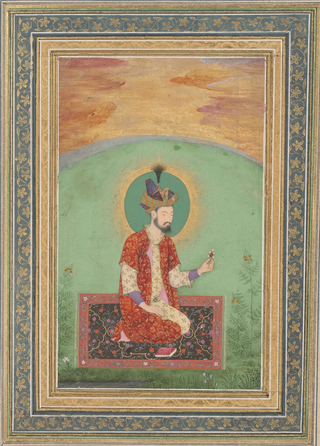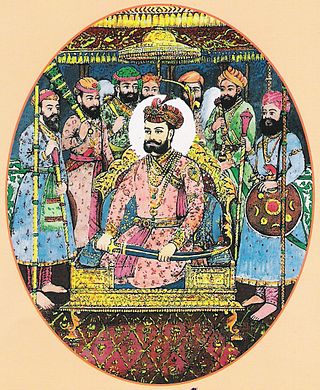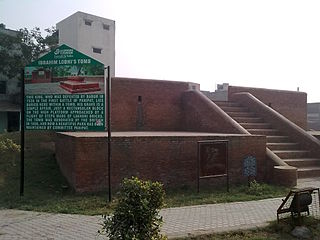
Nasir al-Din Muhammad, commonly known by his regnal name Humayun, was the second Mughal emperor, who ruled over territory in what is now Eastern Afghanistan, Bangladesh, Northern India, and Pakistan from 1530 to 1540 and again from 1555 to his death 1556. At the time of his passing, the Mughal Empire spanned almost one million square kilometres.

Ibrahim Khan Lodi was the last Sultan of the Delhi Sultanate, who became Sultan in 1517 after the death of his father Sikandar Khan Lodi. He was the last ruler of the Lodi dynasty, reigning for nine years until 1526, when he was defeated and killed at the Battle of Panipat by Babur's invading army, giving way to the emergence of the Mughal Empire in India.

The Second Battle of Panipat was fought on 5 November 1556, between Akbar and the king of Delhi, Hemu. Hemu had conquered Delhi and Agra a few weeks earlier by defeating Mughal forces under Tardi Beg Khan in the battle of Delhi and crowned himself Raja Vikramaditya at Purana Quila in Delhi.

Sher Shah Suri, often called the "Just King", was the founder of the Sur Empire in India. He was the regent and later sole ruler of Bihar from 1529—1540 until he defeated the Mughal Empire in 1540, founding the Sur Empire, and establishing his rule in Delhi, crowning himself as Emperor. After his accidental death in 1545 CE, his son Islam Shah became his successor. The influence of his innovations and reforms extended far beyond his brief reign. In his reign, he remained undefeated in battle, being renowned as one of the most skillful Afghan generals ever produced.

Mandu or Mandavgad is an ancient city in the present-day Mandav area of the Dhar district. It is located in the Malwa and Nimar region of western Madhya Pradesh, India, at 35 km from Dhar city. In the 11th century, Mandu was the sub division of the Tarangagadh or Taranga kingdom. This fortress town on a rocky outcrop about 100 km (62 mi) from Indore is celebrated for its architecture.

Panipat is a historic as well as planned industrial city in Haryana, India under HUDA. It is 95 km north of Delhi and 169 km south of Chandigarh on NH-1. The three major battles fought in 1526, 1556 and 1761 took place near the city. The city is famous in India as the "City of Weavers" and "Textile City". It is also known as the "cast-off capital" due to being "the global centre for recycling textiles". Panipat is also home to a variety of manufacturing industries including wool and cotton milling, saltpetre refining, and the manufacture of glass, electrical appliances, and other products. Panipat is included in the list of Critically Polluted Industrial Areas in India. The Comprehensive Environment Pollution Index (CEPI) of the city is 71.91 as against 88.50 of Ankaleshwar (Gujarat). The fatal field of Panipat is the site of three battles that changed the course of India's history, resulting in the creation and confirmation of the Mughal Empire. The third battle led to the decisive defeat of the Maratha Confederacy in North India, which became a dominating power in Delhi by then and paved the way for the British colonial rule of India.

The Agra Fort is a historical fort in the city of Agra, and also known as Agra's Red Fort. Mughal emperor Humayun was crowned at this fort. It was later renovated by the Mughal emperor Akbar from 1565 and the present-day structure was completed in 1573. It served as the main residence of the rulers of the Mughal dynasty until 1638, when the capital was shifted from Agra to Delhi. It was also known as the "Lal-Qila" or "Qila-i-Akbari". Before being captured by the British, the last Indian rulers to have occupied it were the Marathas. In 1983, the Agra fort was inscribed as a UNESCO World Heritage Site because of its importance during the Mughal Dynasty. It is about 2.5 kilometers (1.6 mi) northwest of its more famous sister monument, the Taj Mahal. The fort can be more accurately described as a walled city. It was later renovated by Shah Jahan.

Hemu was an Indian emperor who previously served as a general and Wazir of Adil Shah Suri of Sur Empire during a period in Indian history when Mughals and Afghans were vying for power across North India. He fought Afghan rebels across North India from Punjab to Bengal and Mughal forces of Humayun and Akbar in Agra and Delhi, winning 22 battles for Adil Shah Suri.

The Lodi dynasty was a dynasty that ruled the Delhi Sultanate from 1451 to 1526. It was the fifth and final dynasty of the Delhi Sultanate, and was founded by Bahlul Khan Lodi when he replaced the Sayyid dynasty.

Muhammad Bairam Khan, commonly known as Bairam Khan or Bayram Khan was an important military commander, and later commander-in-chief of the Mughal army, a powerful statesman and regent at the court of the Mughal Emperors, Humayun and Akbar. He was also the guardian, chief mentor, adviser, teacher and the most trusted ally of Akbar. Akbar honoured him as Khan-i-Khanan, which means "King of Kings". Bairam was originally called Bairam "Beg", but later became honoured as Khan. Bairam Khan was an aggressive general who was determined to restore Mughal authority in India.

Delhi has been an important political centre of India as the capital of several empires. The recorded history of Delhi begins with the 8th century Tomar Rajputs kingdom. It is considered to be a city built, destroyed and rebuilt several times, as outsiders who successfully invaded the Indian subcontinent would ransack the existing capital city in Delhi, and those who came to conquer and stay would be so impressed by the city's strategic location as to make it their capital and rebuild it in their own way.

Muhammad Adil Shah was the fourth ruler of the Suri dynasty, a late medieval Afghan dynasty in the northern Indian subcontinent.

Sikandar Shah Suri was the sixth ruler of the Sur Empire, a late medieval Pashtun dynasty of northern India. He became the sultan of Delhi after overthrowing Ibrahim Shah Suri.

Adil Shah Suri was the seventh and final ruler of the Sur Empire. He was the brother in law of Sikandar Shah Suri, who ruled over a region east of Delhi after Sikandar Shah Suri was defeated by Humayun in 1555. He and Sikandar Shah Suri were contenders for the Delhi throne against the Mughal emperor Akbar.
Events in the year 1556 in India.
The Battle of Tughlaqabad was a notable battle fought on 7 October 1556 between a Hindu king Hem Chandra Vikramaditya, also known as Hemu and the forces of the Mughal emperor Akbar led by Tardi Beg Khan at Tughlaqabad near Delhi. The battle ended in a 'victory of Hem Chandra' who took possession of Delhi and claimed royal status, assuming the title of Raja Vikramaditya. Following his failure, Tardi Beg was executed by Akbar's regent, Bairam Khan. The two armies would meet again at Panipat a month later with opposite results.
Taj Khan Karrani was the founder of the Karrani dynasty, a Pashtun dynasty of Karlan-Afghan origin that ruled Bengal, Orissa and parts of Bihar.
Khawas Khan Marwat was one of the best generals of Sher Shah Suri, having played a major role in defeating the Mughal Emperor Humayun in 1539 at the Battle of Chausa. He belonged to the Bahram branch of the Marwat tribe. He was originally a poor fox hunter, but Sher Shah spotted his potential and elevated him to the position of a general. According to historical accounts he was born of a slave woman to a household of Lohani Marwats.

The Tomb of Ibrahim Lodi in Panipat is the tomb of Ibrahim Lodi, Sultan of the Lodi dynasty.
The Battle of Sirhind was fought between the Mughal Empire and the Suri Empire in 1555.















